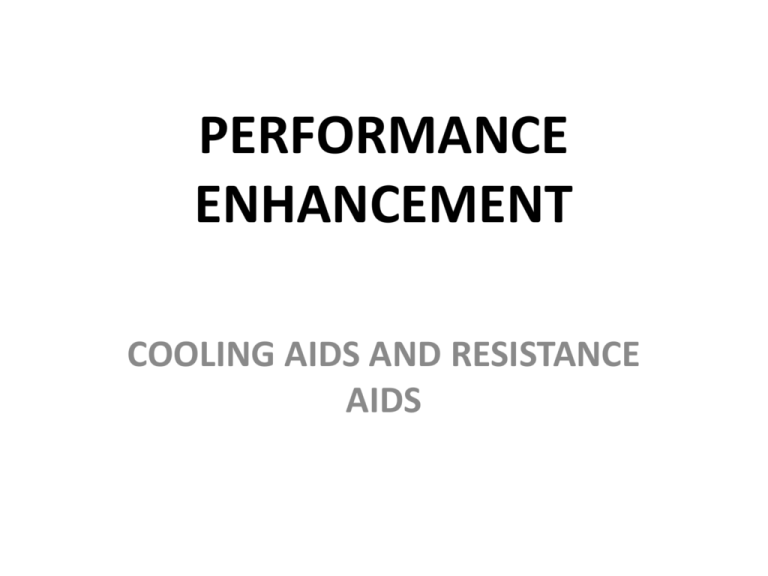PERFORMANCE ENHANCEMENT
advertisement

PERFORMANCE ENHANCEMENT COOLING AIDS AND RESISTANCE AIDS LEARNING OBJECTIVES STARTER COOLING AIDS • These are used prior to an activity to reduce core body temperature to help improve performance or after the activity to improve the recovery process • The main methods include cold air exposure, water immersion/ice baths, fan cooling, cold water spraying, body/head cooling jacket/vest, cold therapy packs/wraps or simply packing ice into damp towels • Cold air exposure and water immersion have been the predominant methods used, but are not practical for most performers • Cooling jackets/vests are highly practical and are made from wet suit material and packed with ice PRE-COOLING • Using a cooling jacket or ice-packed towels aims to reduce skin temperature and consequently core body temperature • It should last between 8-30 minutes during warm-ups and /or the intervals between warm-ups and the start of performance • Temperature guidelines vary between 5 and 16 degrees Celsius • Pre-cooling is advisable before prolonged exercise in hot temperatures as it helps to sustain intensity and speed, reduces thermal strain, allows for different pacing strategies and increases exercise intensity towards the end of performance • Metabolic and cardiovascular responses (reduced heart rate and inaccurate perceived exertion) can be affected during the first 15 minutes of exercise after pre-cooling • Cooling the body too much will hamper the performance and pose a health risk POST-COOLING AND ICE WRAPS/PACKETS POST-COOLING • Cooling treatments used as part of recovery (cryotherapy) may be used in different ways on acute and chronic injuries • The benefits of cooling on damaged soft tissue is now widely accepted • The application of ice in the treatment of injuries to soft tissues to reduce swelling and blood leaking into the tissues has been a long term method, accompanied by compression, elevation and rest (RICE) ICE WRAPS/PACKETS • They are used as part of RICE to help provide immediate treatment and to speed up recovery of any soft tissue injuries ICE BATHS • These have been used for their pain-relieving properties in the treatment of injuries • More recently the belief is that: – Blood vessels constrict and blood flow is drained away from that muscles that have been working (removing lactic acid) – Once out of the bath the capillaries dilate and ‘new’ blood flows back to the muscles, bringing with it oxygen that will help the functioning of the cells • This process is thought to improve muscle function, reduce muscle damage and decrease soreness associated with DOMS • Therefore, this not only treats injury and pain, but helps with injury prevention and exercise recovery • Ice baths are popular in contact sports (rugby and Football) and with endurance athletes • Whole-body ice baths would be used for contact sports like Rugby and for Football, running, Hockey etc, only immersion of the lower limbs would be needed ICE BATHS • The process involves the performer immersing body parts at a temperature between 5-16 degrees Celsius for 7-10 minutes (shorter for pain relief) • Initially start with 1 minute sessions and progress to a maximum of 10 minutes over a period of 10 weeks • Once in the ice bath, athletes should keep moving around to prevent warm water from forming around their limbs • However, there are various concerns with the use of ice baths: – Different individuals have different sensitivity to ice (some find it immediately painful) – If used on the chest the cold may cause muscle reaction, bringing about angina pain from constriction of coronary arteries – Check skin sensitivity/touch before applying ice as it may indicate nerve impingement and ice will hide or complicate the problem – Do not use with high blood pressure as vasoconstriction will increase blood vessel pressure – There is decreased efficiency with vasoconstriction (particularly affecting older people) – The ice burns if place directly onto skin and can cause tissue/vascular impairment if held on the skin for too long (more than 10 minutes) RESISTANCE AIDS • • • • PULLEYS These provide a form of resistance to apply force against to develop strength, in the same way as weights on a multigym The main advantage of pulleys is that they better meet the principle of specificity as they can match more closely the actual movement patterns used in the performance of an activity A cheaper alternative to pulleys are elasticated resistance bands, which do not replicate the smoothness of movements that pulleys offer Swimmers can benefit from pulley resistance/ergometertype machines that allow them to lay flat and replicate the movement patterns of various strokes against a resistance during the arm action RESISTANCE AIDS • • • • • • PARACHUTES These increase the resistance to apply a force against while maintaining the movement They are used predominantly in sprint-type running activities These are a better form of resistance training than lifting weights with the legs while the body is in a sitting or standing position The downside is that parachutes make athletes run with a slower arm and leg action which is not specific to sprinting Although there is no solid evidence that parachutes improve sprint performance in comparison to conventional training, it provides fun and variety to a training regime Ankle and wrist weights are two other forms of resistance aids which are comparable with parachutes PLENARY







